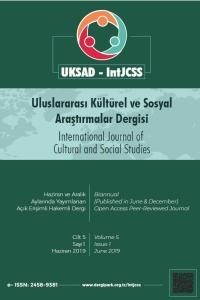The Evaluation of Social Media within the Context of the Silencing System
New Media, Social Media, Socialization Silencing,
___
- Referans1: Atabek Ü., (2005), “İletişim Teknolojileri ve Yerel Medya İçin Olanaklar”, Sevda Alankuş (Derleyen), Yeni İletişim Teknolojileri ve Medya, 2. Baskı, İstanbul: IPS İletişim Vakfı Yayınları.
- Referans2: Binark M., Yıldırım A.. Toprak A., Aygül E., Börekçi S.,Çomu T., (2009), Toplumsal Paylaşım Ağı Facebook: “Görülüyorum Öyleyse Varım”, İstanbul: Kalkedon Yayınları.
- Referans3: Boyd D. M. and Ellison N. B. (2007). “Social Network Science Sites: Definition, History and Scholarship” Journal of Computer Mediated Communication, 13, http://onlinelibrary.wiley.com/doi/10.1111/j.1083-6101.2007.00393.x/full
- Referans4: Dutton J.E., Ashford, S.J., O’Neil, R.M., Hayes, E. and Wierba, E.E., (1997), “Reading the wind: How middle managers assess the context for selling issues to top managers”, Strategic Management Journal, 18 (5): 407-425.
- Referans5: Karagülle A. E. and Çaycı B. , (2014), “Ağ Toplumunda Sosyalleşme ve Yabancılaşma”. The Turkish Online Journal of Design, Art and Communication - TOJDAC January 2014 Volume 4 Issue 1.
- Referans6: Laughey D., (2010), “Medya Çalışmaları-Teoriler ve Yaklaşımlar”, İstanbul: Kalkedon Yayınları.Mutlu E., (2008), “İletişim Sözlüğü”. Ankara: Ayraç Kitapevi.
- Referans7: Neumann E. N. (1998). “Kamuoyu, Suskunluk Kavramının Keşfi”, (Çev. Murat Özkök), Ankara: Dost Kitabevi Yayınları.
- Referans8: Pinder C. C. and Harlos K. P. (2001), Employee silence: Quiescence and acquiescence as responses to perceived injustice, Research in Personnel and Human Resources Management. Volume 20.
- Referans9: Şehitoğlu Y., (2010), Örgütsel Sessizlik, Örgütsel Vatandaşlık Davranışı ve Algılanan Çalışan Performansı İlişkisi. Yayımlanmış Doktora Tezi, Gebze Yüksek Teknoloji Enstitüsü Sosyal Bilimler Enstitüsü.
- Referans10: Yağcı Y., (2009), Web Teknolojisinde Yeni Bilgi Fırtınası: Web 3.0. ÜNAK Bilgi Çağında Varoluş: “Fırsatlar ve Tehditler” Sempozyumu, İstanbul: Yeditepe Üniversitesi Bildiriler Kitabı.
- Başlangıç: 2015
- Yayıncı: Mutlu TÜRKMEN
Kore Savaşı’na Belgesel Film Yoluyla Bakış: “Mümtaz Birlik”
Çiğdem ÖZKAN, Hatun BOZTEPE TAŞKIRAN
Kırgızistan'da E-Ticaret Uygulamaları ve Tüketicilerin Satın Alma Sürecinde Kanaat Önderlerinin Rolü
Aslı YURDİGÜL, Ayşe Nur YILMAZ
Sosyal Medya’da Dijital Yemek Kültürü
Cinsiyet Ayrımcılığı Bağlamında Yazılı Basında Haber Seçimlerinin İncelenmesi
Optimization of Spirituality and Akhlaq of Islamic Youth through Da'wah Billisan Da'i
